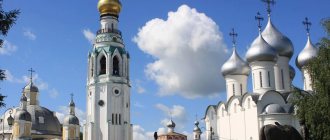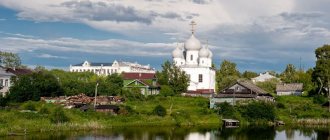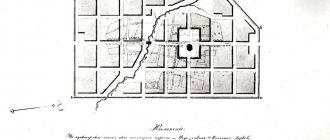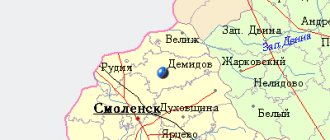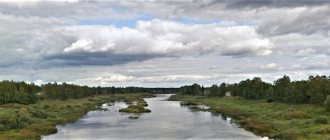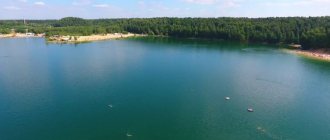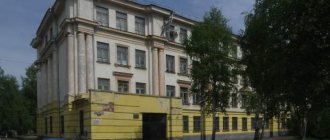Vologda Region
Russia includes 23
urban settlements
, including[1][2][3]:
- 15 cities, among which stand out: 4 cities of regional significance ( highlighted in orange
), of which, within the framework of the organization of local self-government: 2 cities form urban districts, - 2 cities are included in the corresponding municipal districts;
What holiday is it today?
January 22, 2022, Saturday
Today are holidays, events: Day of Unification of Ukraine Tomorrow: Premiere of the opera “Eugene Onegin” at the Bolshoi Theater
Today is the Orthodox holiday: Martyr Polyeuctus. St. Philip, Metropolitan of Moscow and All Russia, wonderworker... Tomorrow: St. Gregory, Bishop of Nyssa. Venerable Markian the presbyter. Venerable Dometian, Bishop of Melitino. St. Paul of Komel, wonderworker, student of St. Sergius of Radonezh. Saint Theophan, the Recluse of Vyshensky...
Today is a national holiday: St. Philip's Day... Tomorrow: Gregory - Summer Guide...
Seasons
Seasons, four periods of the year (spring, summer, autumn and winter) characterized by certain average temperatures. The period during which the Sun passes through one of these sectors is called the season. Spring in the Northern Hemisphere and autumn in the Southern Hemisphere begin when the Sun passes through the initial circle of declination and its right ascension is 0° (vernal equinox). Summer in the Northern Hemisphere and winter in the Southern Hemisphere occur when the sun's right ascension is 90° (summer solstice). Autumn in the Northern Hemisphere and spring in the Southern Hemisphere begin when the sun's right ascension is 180° (autumnal equinox). The beginning of winter in the Northern Hemisphere and summer in the Southern Hemisphere is considered to be the winter solstice, when the direct ascension of the Sun is 270°... Next: Seasons. Russian folk calendar. Monthly words...
Folk calendar about every day
Every day one season always replaces another and this determines a person’s way of life. In connection with this, a folk calendar was formed in which there were practically no nameless, unmarked days. Every day was special, had its own purpose. All this was determined by climate conditions and astrological phenomena.
A calendar is a system for counting periods of time. The first calendars arose a long time ago, in ancient times, because there was a need to measure time. The word calendar comes from the Latin words caleo - to proclaim and calendarium - debt book. This is due to the fact that in Ancient Rome the beginning of each month was especially proclaimed, and because it was customary to pay debts on the first day of the month. Different peoples counted time differently. Some calendars are based on the changing phases of the moon - lunar calendars; in others - the change of seasons - sunny; in others, the length of the year was coordinated with the change of seasons, and the counting of months was associated with the phases of the Moon. Such calendars are called lunisolar.
In Rus', the calendar was called a monthly calendar. Every day, the month book covered the entire year of peasant life, “describing” day by day, month after month, where each day had its own holidays or weekdays, customs and superstitions, traditions and rituals, natural signs and phenomena. The cyclical nature of the calendar is reminiscent of human life, where spring is youth, summer is heyday, autumn is the time of harvesting fruits (it’s good if there are some, otherwise you can live your life without collecting fruits), winter is the time of wisdom and peace. This cyclicality and rhythm determined the way of life of the farmer. The folk calendar was an agricultural calendar, which was reflected in the names of the months, folk signs, rituals and customs. Even the determination of the timing and duration of the seasons is associated with real climatic conditions. Hence the discrepancy between the names of the months in different areas... Next: Folk calendar...
Economy and industry of the Vologda region
Ferrous metallurgy and electric power are considered an important industry in the region. A map of the Vologda region will allow you to find all the main enterprises in the region.
Important organizations are considered to be a steel rolling plant in Cherepovets, a bearing plant in Vologda, a woodworking plant, and a metal structures plant. The region exports various food products: butter, milk, meat.
The region is also famous for its traditional crafts. This is lace, blackening on silver, and also carved birch bark.
Yandex maps of the Vologda region will help you find important agricultural enterprises related to dairy farming.
Among the interesting cities with a rich cultural heritage are Ustyuzhna, Belozersk, Vologda, and Veliky Ustyug.
Fishing calendar for every day
The fishing calendar should not be taken as an absolutely indisputable truth. Fish biting is greatly influenced by a whole range of natural factors, as well as the influence on the nature of man himself. You must not forget that the fish’s bite depends and is determined not only by the calendar dates and biological cycles of their life, reflected in the calendar, but also, no less, by the state of their habitat; the bite also depends on weather conditions: air and water temperatures, cloudiness, wind direction and strength, etc... Next: Fishing calendar...
Central districts of the Vologda region on the map
The vast territory of the region is divided into many districts on the map of the Vologda region. Important areas of the city include:
- Babaevsky district is located in the west of the region. Its territory extends to the Mologo-Sheksninskaya lowland.
- Babushkinsky is considered one of the cleanest districts in the region . There are few businesses in its area. In the vicinity of the city there is a taiga massif. The area is a balneological resort. Salt mines were developed in the area, and subsequently healing mineral springs were discovered. A map of the Vologda region by district will help you find them.
- The central regions include the Veliky Ustyug region . Important industries include wood processing and forestry. In the area there is a plywood mill, a timber industry enterprise, a distillery, as well as tanneries and the production of natural fabrics.
- The Sokolsky district also stands out . It is located on the territory of the Prisukhonskaya Lowland. Important transport lines pass through the area. This is a highway, a waterway along the Sukhona River, and also a railway line.
- The map of the Vologda region displays in detail all objects of the Sheksninsky district . There are railway stations in the area: Shelomovo, Sheksna, and Chebsara.
Orthodox calendar about every day
Orthodox calendar: Orthodox, Church and Christian holidays.
The church year is an alternation of weekdays and holidays. On weekdays, a person is called to work “by the sweat of his brow to earn his bread.” Holidays are given in order to feel liberation, to rise above the bustle and routine of the world, to feel involved in the highest of worlds, “where there are no illnesses, sorrows and sighs, but endless life.” Since ancient times, holiday cycles have been associated with the seasons. The pagans associated them with the worship of the forces of nature, the cult of which in the Old Testament was replaced by gratitude to the Creator for the universe. And although the connection between holidays and the seasons has not completely lost its power, since God is present in everything, in the plant and animal world, in human works, it nevertheless faded into the background, giving way to a spiritual foundation built on the Sacred Scriptures. The history of Orthodox holidays dates back to the times of the Old Testament. Each of the Orthodox holidays is dedicated to the remembrance of the most important events in the life of Jesus Christ and the Mother of God, as well as the memory of saints... Next: Orthodox calendar...
Map of the Vologda region with cities and villages
The Vologda region includes many interesting cities.
- Vologda is considered the main city of the region. This is an ancient city. It is located on the territory of the Sukhona depression. Vologda lies on the coast of the river of the same name. Also, many other rivers flow through its area. Currently considered an important manufacturing center. Mechanical engineering is developed on the territory of the settlement. It is a scientific and cultural center. There are more than two hundred architectural and historical monuments on its territory. The historic city center is divided into several districts. Among the large enterprises we can highlight an optical-mechanical enterprise, a bearing plant, and a dairy plant. The city is famous for its wooden architecture, lace, and stone architecture.
- By selecting a road map of the Vologda region, you can get to Cherepovets, which is located in the center of the East European Plain. This is the largest city in the region, which began to develop thanks to the metallurgical industry. The basis of the city's economy is formed by organizations in the chemical industry, as well as ferrous metallurgy. The city is also involved in metalworking, construction and light industry. There are more than 1.5 thousand companies in Cherepovets. The city is also a major port.
- Using a map of the Vologda region with cities in good quality, you can find the city of Sokol. It is one of the most important cities in the region, as it is a center for the pulp, wood and construction industries. Important organizations in the city include a wood processing plant, as well as a meat processing plant and a dairy canning plant.
- Veliky Ustyug is considered one of the oldest cities in the region. The routes of the Vologda region on the map will help you visit all the cultural and historical sights of the city. Family tourism is developing on its territory, and the city is also the birthplace of Father Frost. Tourists visit this city for its unique attractions. These are more than 20 different temples dating back to the 17-18 centuries. And also the famous museum-reserve, which consists of several museums. The city has a variety of medical and health institutions.
- Gryazovets can be found using a map of the Vologda region with cities and villages. The city is crossed by the Rzhavka River. Among the enterprises in the city, one can note an automobile repair plant, a building materials plant, as well as the Northern Milk organization. Tourists are recommended to visit the cedar grove, stone mansions of the 19th century, as well as ancient churches.
- 6. A map of the Vologda region with villages will help you find the city of Babaevo. The city's territory is predominantly flat.
Russian folk calendar for every day
The word “sign” comes from the word “notice”, i.e. observe. As a result of observing what happens around a person every day, he accumulates life experience. This knowledge was passed down from generation to generation, carefully preserved and people trusted it as a sacred book. Many signs have come to us from the depths of centuries without losing their knowledge. Each of us is free to choose: to dismiss all this as an absurd superstition or to take a closer look at the signs and take the centuries-old experience of generations more seriously. Most of us, when taking exams, ask them to scold them, boasting about some kind of good fortune or luck, spit so as not to jinx them or knock on wood, take a detour if a black cat crossed the road, are afraid of the number 13 and much more. And who among us does not have lucky things, numbers? Who has never resorted to the help of fate at least once in their life, who has not believed in secrets? It’s as if everything connected with signs is hidden somewhere deep in our subconscious. Often we remember them mechanically, unconsciously, or just as a joke. But, undoubtedly, the signs contain a lot of accurate knowledge and practical wisdom of our ancestors. They cover all the characteristic, often difficult to perceive, natural phenomena. Signs have preserved a lot of what was in old folk holidays and customs; they help predict the weather, grow crops... Next: Folk signs...
Urban settlements[ | ]
| № | Name | district / city of regional significance[7] | municipal district[8] | population (persons) | founding/first mention | town status | coat of arms | former names |
| 1 | Vozhega | Vozhegodsky district | Vozhegodsky district | ↘6045[4] | 1895 | 1932 | ||
| 2 | Vokhtoga | Gryazovets district | Gryazovets district | ↘5247[4] | 1960 | |||
| 3 | Kaduy | Kaduysky district | Kaduysky district | ↗11 023[4] | 1947 | |||
| 4 | Cousineau | Veliky Ustyug[5] | Veliky Ustyug district | ↘897[4] | 1938 | |||
| 5 | Sazonovo | Chagodoshchensky district | Chagodoshchensky district | ↘2706[4] | 1860 | 1947 | until 1923 - White Crosses | |
| 6 | Khokhlovo | Kaduysky district | Kaduysky district | ↘2294[4] | 1979 | |||
| 7 | Chagoda | Chagodoshchensky district | Chagodoshchensky district | ↘5777[4] | 1926 | 1932 | ||
| 8 | Sheksna | Sheksninsky district | Sheksninsky district | ↘18 488[4] | 15th century | 1954 | until 1954 - Nikolskoye |
Lost the status of the town[ | ]
- named after Zhelyabov - a town since 1945. Transformed into a rural settlement in 2000[9].
- Krasavino has been a town since 1927. Incorporated into a city in 1947.
- Dairy - town since 1948. Transformed into a rural settlement in 2004[10].
- Sokol has been a town since 1925. Incorporated into a city in 1932.
- Suda has been a town since 1960. Converted to a rural settlement in 1999.
- Tonshalovo has been a town since 1989. Transformed into a rural settlement in 2004[11].
- Ustye has been a town since 1932. Converted to a rural settlement in 2004.
- Chebsara has been a town since 1931. Converted to a rural settlement in 2012.
- Kharovsk has been a town since 1932. Incorporated into a city in 1954.
Holiday calendar, dates and events of the year
All state and professional holidays in Russia, including significant World and International holidays, and other equally interesting holidays and events about every day.
The holiday has always kept pace with the history of mankind. Social time can be divided into three types: everyday life (weekdays), weekends and holidays. Everyday life is a series of practices repeated day after day and every day (work). Weekends are regular breaks from the rush of everyday life. It is believed that on weekends a person should restore his strength after working days. Day off, non-working day. A holiday is a day of celebration established in honor or in memory of someone or something. A day or series of days celebrated by the church in memory of a religious event or saint... Next: Calendar...
Prayer book, Orthodox prayers for every day
Prayer is the most powerful means for healing all illnesses - both physical and mental. Prayers can be laudatory or grateful, petitionary and repentant. If we have offended God, sinned, we must ask Him for forgiveness, that is, repent. Such prayers are called repentant prayers. If everything is fine with us, if we and our loved ones are healthy and prosperous, if we have a place to live, something to wear, something to eat, we must glorify and thank God for this. Such prayers are called praise or thanksgiving. If some misfortune, illness, trouble or need happens, you need to ask God for help. Such prayers are called petitionary... Next: Orthodox prayers...
Zodiac, astrological, eastern calendar. Zodiac signs
In ancient times, to establish the calendar, priests used knowledge of the positions of all the planets. Before the reform of Peter 1, the New Year was celebrated on the Day of the Autumn Equinox. On this day, according to ancient legend, the most peaceful treaty was concluded between the Great Race (ancient Slavs) and the Great Dragon (ancient Chinese) and it was approximately 7518 years ago... For the ancient Slavs, the calendar month corresponded to the lunar cycle from new moon to new moon, taking into account such Thus, the relationship of the entire annual cycle with astronomical and natural phenomena. There was no coherent calendar system. The main natural phenomena are still considered to this day to be the days of the solar equinox and solstice - the Slavic holidays Maslenitsa, Kupala, Ovsen and Kolyada. But during the time of Peter 1, all ancient Slavic calendars were abolished and a new Western European calendar from the Nativity of Christ (Julian calendar) was introduced, while the beginning of the calendar was moved to January 1. The Julian calendar (old style) did not take leap days into account and accumulated one extra day every 128 years. After the October Revolution in 1918, the Gregorian calendar (new style) was introduced in Russia, according to which an amendment of 13 days was introduced. The calendar of the ancient Slavs was based on two planets: the Sun and the Moon. And now they don’t use anything at all. The calendar has become static. There is no such thing as the calendar, it turns out, resting on some planet. Nobody even knows about it. There are just some standard numbers, there are months and holidays. The calendar is based on the Sun and Moon. Why is this so? Because these two luminaries influence the Earth. The Earth revolves around the Sun, and the Moon revolves around the Earth. And these two luminaries create the atmosphere on the planet. From here the calendar is built... Next: Astrological calendar...
Cities[ | ]
| № | Name | district / city of regional significance[7] | municipal district / urban district[8] | population (persons) | founding/first mention | city status | coat of arms | former names |
| 1 | Babaevo | Babaevsky district | Babaevsky district | ↗11 416[4] | 1902 | 1925 | ||
| 2 | Belozersk | Belozersky district | Belozersky district | ↘8464[4] | 862 | 862 | Beloozero | |
| 3 | Veliky Ustyug | Veliky Ustyug[5] | Veliky Ustyug district | ↗31 078[4] | 1147 | 1147 | Ustyug | |
| 4 | Vologda | Vologda | Vologda, GO | ↘308 530[4] | 1147 | 1147 | ||
| 5 | Vytegra | Vytegorsky district | Vytegorsky district | ↘10 116[4] | 1496 | 1773 | ||
| 6 | Gryazovets | Gryazovets district | Gryazovets district | ↘14 797[4] | 1538 | 1780 | Gryazovitsky, Gryazlevitsy | |
| 7 | Kadnikov | Sokolsky district | Sokolsky district | ↘4440[4] | 1492 | 1780 | ||
| 8 | Kirillov | Kirillovsky district | Kirillovsky district | ↘7371[4] | 1397 | 1776 | ||
| 9 | Krasavino | Veliky Ustyug[5] | Veliky Ustyug district | ↘5827[4] | 1947 | |||
| 10 | Nikolsk | Nikolsky district | Nikolsky district | ↗7960[4] | 15th century | 1780 | Nikolsky Pogost | |
| 11 | Falcon | Falcon[6] | Sokolsky district | ↘36 067[4] | 1615 | 1932 | Sokolovo | |
| 12 | Totma | Totemsky district | Totemsky district | ↘9652[4] | 1137 | 1780 | Totemskaya Salt, Usolye Totemskoe | |
| 13 | Ustyuzhna | Ustyuzhensky district | Ustyuzhensky district | ↘8284[4] | 1252 | 1252 | ||
| 14 | Kharovsk | Kharovsky district | Kharovsky district | ↘8650[4] | 1903 | 1954 | ||
| 15 | Cherepovets | Cherepovets | Cherepovets, GO | ↘312 091[4] | 1362 | 1777 |
Lost city status[ | ]
Preserved, but lost city status:
- Charonda is now a village. The city from 1708 to 1776.
Dream books online, interpretation of dreams
A dream book is nothing more than an interpreter of dreams and dreams, a translator of dreams. Since ancient times, people have been using dream books; dreams have always been given great importance, and people have often noticed the prophetic properties of some dreams. The dream book can become your faithful assistant every day and throughout your life, thanks to the dream interpreter you can always make the right decisions, the dream book will help you resist temptations in time, and will warn you against wrong steps and frivolous actions. Further…
